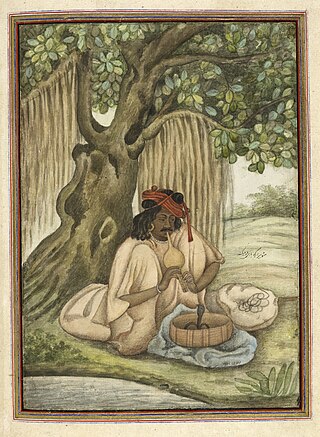Related Research Articles
The Bangali may refer to a Scheduled Caste found in northern India. They are one of the many nomadic groupings found in India, and have customs similar to other nomadic communities such as the Kanjar.
Bazigar, or Goaars, are an ethnic group of north-western India. They are primarily found in Punjab and in Pakistan's Punjab, but there are also communities in Haryana, Uttar Pradesh, Delhi, Chandigarh, Himachal Pradesh, Jammu and Kashmir, and Rajasthan. They were previously nomadic with their main occupation the performance of acrobatics and other forms of entertainment, but they are now settled and engaged mainly in agricultural and similar forms of labour.

Nomads are known as a group of communities who travel from place to place for their livelihood. Some are salt traders, fortune-tellers, conjurers, ayurvedic healers, jugglers, acrobats, actors, storytellers, snake charmers, animal doctors, tattooists, grindstone makers, or basketmakers. Some anthropologists have identified about 8 nomadic groups in India, numbering perhaps 1 million people—around 0.12 percent of the country's billion-plus population. Aparna Rao and Michael Casimir estimated that nomads make up around 7% of the population of India.
The Sunar is a caste in India and Nepal.The Sunar community work as traders of gold or as goldsmiths. The community is primarily Hindu, Buddhist, Christian, Muslim and found all over India and Nepal.

The Sapera are a Hindu caste found in North India. They are also known as Barwa Sampheriya in West Bengal, Sapela in Punjab and Sparera in Madhya Pradesh.

The Nat are a caste found in northern India. Their traditional occupation has been that of entertainers and dancers.
The Sikligar is a community found in the Indian states of Gujarat, Haryana, Rajasthan, and Punjab. By tradition, the Sikligar people specialized in the craft of making and polishing weapons. They are typically Hindu in Gujarat, Telangana, and Andhra Pradesh; Sikh in Punjab; and either Hindu and Sikh in Haryana.
The Perna are a Hindu caste found mainly in the state of Haryana in India.
The Bharbhunja are an occupational caste found in North India and Maharashtra. They are also known as Kalenra in Maharashtra. A small number are also found in the Terai region of Nepal.
The Lakhera are a Hindu caste found in North India. In Uttarakhand, Lakhera caste is found among Sarola Brahmins and are not considered OBC. They are a community traditionally associated with bangle making.
The Sirkiband are a Hindu caste found in the states of Haryana and Punjab in India. They have scheduled caste status in Haryana. A small number in Punjab are now Sikh.
The Singikat are a Hindu caste found in the state of Haryana, India. They are known as Gyarah.
The Deha, sometimes pronounced as Dhaya, Dhea, Daiya and Dheya are a caste found in India, and have Scheduled caste status in Haryana.
The Gandhila sometimes pronounced as Gandhil and Gandola, are a Hindu caste found in North India. They have scheduled caste status in Punjab and Haryana.
The Kuchband are a Hindu caste found in the state of Haryana in India. They are also known as Gihara. The name Kuchband is derived from the Hindi word kuch, meaning a weavers brush, on account of their traditional occupation of manufacturing kuches. According to their traditions, the community emigrated from Rajasthan some three centuries ago. They are now found throughout Haryana, and speak Haryanvi. According to other traditions, the Kuchband are a sub-group of the Singikat community. Like other Hindu artisan castes, they no longer practice their traditional craft. Most Kuchband are now landless agricultural labourers.
The Heri are a Hindu caste found in the states of Haryana and Punjab in India.
The Ghasiara are a Khatri Hindu caste found in the states of Punjab and Haryana in India. They are also known as Ghasi and Lodha.
The Rai Sikh is a Sikh community, mainly found in the states of Punjab, Rajasthan, Uttar Pradesh, Uttrakhand, Delhi and Haryana in India.
Bharai are a Muslim community found in India and Pakistan. They are settled in the states of Himachal Pradesh and Punjab in India, and in Punjab province and Karachi in Pakistan. They are also known as Parahin and in Uttar Pradesh, the Bharai are also commonly known as Sheikh Sarwari. It is also the name of a Jat and Rajput clan.
The Chirimar are a Hindu caste found in the state of Haryana in India. They are also known as Baheliya.